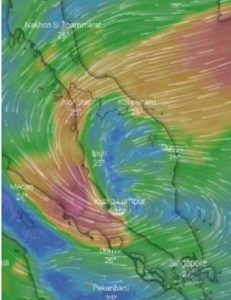
‘Depression 29’ with strong winds and rain over the Klang Valley in Malaysia.
Is flying in the rain and wind safe?
Emily G from Quora asks the above interesting question.
Five days ago, ‘Depression 29’ brought heavy rain into the Klang Valley in Malaysia. It lasted for over 24 hours and recorded 363 millimeters of rainfall onto parts of the valley. That single day exceeded the monthly average rainfall level and according to the meteorological expert, this only happened once in 100 years!
On that evening, I was alerted by the gust of winds when my outdoor wind chime started to shake violently. I looked at the rainy sky and gusty winds and thought, thankfully, I was no longer flying. I did not wish to face such weather again!
Flying in rain is not by itself unsafe as long as the visibility and winds are within limits.
Additionally, the captain has to consider that the reported braking action on the runway is suitable. If not, he must discontinue with the approach and divert to an alternate airport.
A wet and contaminated runway do pose further problems to a landing aircraft due to the aquaplaning (skidding) effect. This may reduce the effectiveness of wheel braking on landing and may cause a plane to run off the runway.
Generally, moderate rain does not have nearly as much impact on the visibility than as fog or snow do. The only real danger to flying in heavy rain is that it can be associated with strong crosswinds.
This combination of rain and crosswind outside the prescribed limitations is most dangerous during a landing or even on a take-off.
I remember an incident many years back in Shanghai where I refused to take off on a Boeing 777 because of such hazards. It attracted a very amusing innuendo from an irate passenger.
While waiting in the departure lounge, this angry passenger told the manager in charge, “How come that Boeing 777 parked beside us was able to take off while our captain could not?”
Of course, as the storm intensified a moment later, the airport was closed. As such, the flight was delayed for another day until the typhoon had swept past the airport.
In the past, heavy rain has contributed to some accidents:
In July 2007, a TAM Airlines Airbus A320 crashed and burst into flames at one of Brazil’s busiest airports killing at least 200 people. The plane skidded off the runway on landing during heavy rain. It then shot across a busy highway and crashed into several buildings.
On August 2005, an Air France Airbus A340 overran the runway at Toronto International Airport in heavy rain. The aircraft was destroyed in a post-accident fire. Miraculously, there were no casualties.
On September 23, 1999, a Qantas Boeing 747-400 jumbo jet arriving at Bangkok, after a flight from Sydney, ran off the runway while landing in heavy rain. All the passengers evacuated safely.
Yes, only flying in heavy rain and strong cross winds can be a safety hazard during take-off or landing.
See a video on a BOEING 747 landing in Rain and Crosswind here